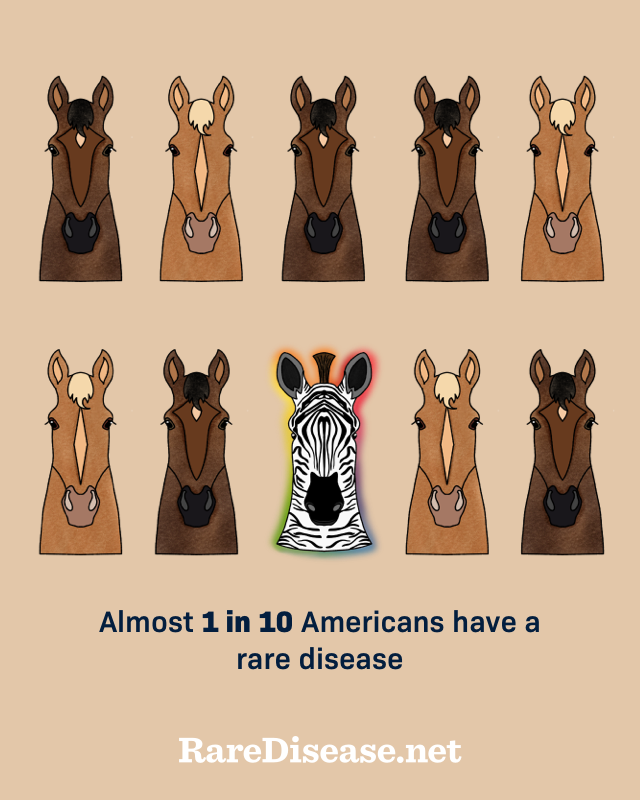What Is a Rare Disease?
Reviewed by: HU Medical Review Board | Last Reviewed: September 2022 | Last updated: July 2023
The definition of what makes a disease rare is different around the world. In the United States, the government says that a disease is rare if it affects fewer than 200,000 people. The European Union defines a rare disease as one that impacts fewer than 1 in 2,000 people.1
So far, doctors have found about 7,000 known rare diseases worldwide. Some have been known for hundreds of years, like cystic fibrosis and hemophilia. Others have only recently been discovered. Many are known only by their genetic description, such as 16q24.1 microdeletion syndrome.1,2
Symptoms and a disease's impact on a person's life can be dramatically different from one rare condition to another, and even from person to person with the same disease. That is why more research and community connections are so important to understand rare diseases.3
Who is affected by rare diseases?
About 30 million people in the United States and 300 million worldwide live with a rare condition.1,3
Roughly 3 out of 4 rare diseases are genetic. Fabry disease and Gaucher disease are examples of rare diseases caused by a change in genes. Of people whose diseases are caused by genetics, 7 out of 10 start having symptoms soon after birth or in childhood.3
The rest are caused by infections, allergies, or something in the environment. Human monocytic ehrlichiosis is just one example of a rare disease caused by bacteria from a tick bite. Extrinsic allergic alveolitis is caused by an allergic reaction after a person repeatedly inhales something in the environment that inflames the lungs.2-5
Figure 1. Rare diseases are more common than you may think

Rare diseases take a heavy toll on children. Half of all people affected by rare diseases are children, with 3 out of 10 dying before age 5. About 1 in 4 infant deaths that occur in intensive care are due to a rare disease.6,7
Rare conditions have a heavy impact on all ages, with up to 10 percent of all hospital visits related to a rare disease.7
Treating rare diseases is hard
Treating a rare disease is difficult partly because these conditions are hard to diagnose correctly. It takes an average of 6 to 8 years to get an accurate diagnosis. Without a diagnosis, treatments may or may not relieve symptoms or stop long-term damage. This is one reason why 6 out of 10 rare diseases lead to a reduced lifespan.7
Rare diseases are sometimes called "orphan diseases." This is because medical expertise and care are limited, and research is rare. Orphan drugs are often drugs without enough people to make development profitable for drug companies.1,8
Only 500 of 7,000 rare diseases have treatments approved by the US Food and Drug Administration (FDA). This means more than 9 out of 10 rare diseases do not have an approved treatment.6,8
To help address this issue, the US Congress passed the Orphan Drug Act in 1983. The Orphan Drug Act was designed to make it more profitable for drug companies to develop treatments for rare diseases. Companies may request an orphan drug designation and get:9,10
- Tax credits for clinical studies of people with a rare disease
- Fee waiver that saves the company almost $3 million
- 7 years of market exclusivity for prescriptions to treat the orphan disease upon approval
- Access to grants that support development of new drugs for rare disease
So far, the FDA has approved more than 70 products for rare diseases since 1983.10
Research into rare diseases
With rare diseases impacting more people than cancer and AIDS combined, it is important to gain a better understanding of these conditions. In 2016, the US government began funding natural history studies of rare diseases. Natural history studies document how a disease progresses over time without treatment. These studies record:7,10-12
- A person's symptoms and complications over time
- Their ability to function day-to-day
- Any treatments that may bring relief or a cure
Natural history studies help doctors learn more about a little-known disease and may be:11
- Retrospective studies – Looking back, such as analyzing old medical records
- Prospective studies – Looking forward by following affected people over time
- Survey studies – Questionnaires that collect information from people living with a rare disease or their caregivers
This knowledge can help doctors develop treatments, such as those that target specific genetic mutations causing a rare disease. This can make clinical studies faster and more efficient, and improve patient care.11,12
Clinical studies may be a good way to take part in improving the treatment and management of your rare disease. Talk with your doctor about your interest in joining a clinical study. There might be a clinical study that can help you and advance treatment for others.